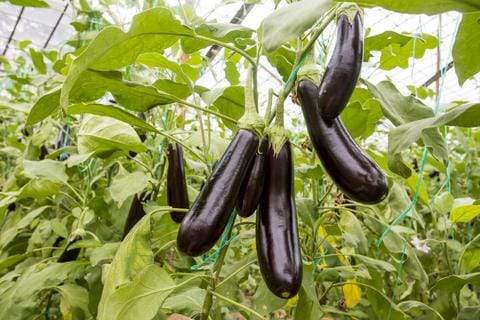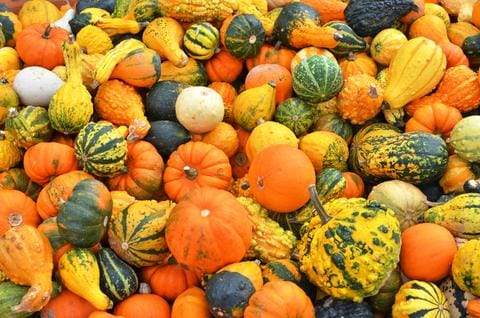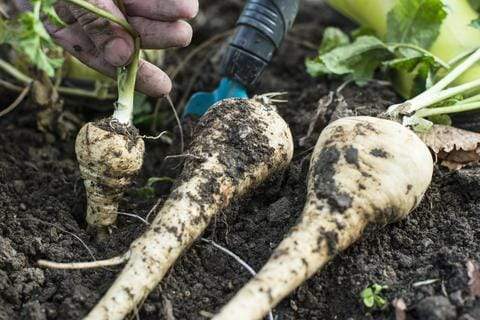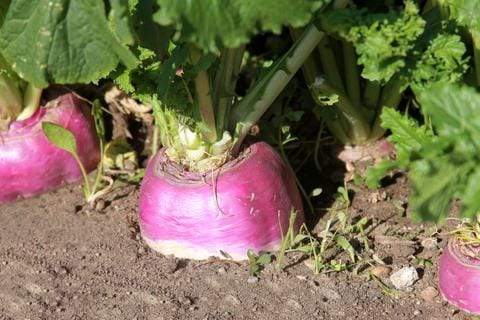Everyone has their favorite gardening seed go-to's. At Pinetree Garden Seeds, we always try to keep things fresh by planting new types of seeds each year alongside our more popular garden vegetable seeds. Try some of our more unique garden seeds, like organic and heirloom rutabaga seeds, parsnip seeds, gourd seeds, and see what happens in your garden!
Summer Squash Seem Stale? Plant Eggplant!
Of all the unique and unusual seeds we suggest below, none have the wow factor of gorgeous, globular (or elongated!) eggplants in deep purple, creamy ivory, or tiger-striped orange. And these fascinating plants are more than decorative—they are both delicious and nutritious. In fact, they have the widest variety of vitamins and minerals of any crop on this list!
If you have at least a three-month growing season with warmer temperatures and you find yourself getting tired of summer squash as the season goes on, swap out some of your squash for eggplant.
Eggplant
Growing eggplant is surprisingly easy for such an exotic-looking crop—but as you might expect for a vegetable that comes from India, warmer temperatures are a must. Up in rural Maine, our growing season is quite short, so Pinetree Garden Seeds gardeners like raised beds for eggplant—they warm up much faster than traditional beds. Covering eggplants with floating row covers can also keep them at a comfortable temperature after transplanting.

- Plant Eggplants thrive in the heat and take time to mature, so start your eggplant seeds indoors and transplant them to a sunny spot after hardening off your seedlings. Wait until seedlings are at least 3” tall before moving them outside. Our recommended eggplant companion plants are peppers, potatoes, or spinach.
- Pick Wait until the skin of the fruit takes on a glossy sheen and firmness. (When you press the skin, does it spring back or stand firm? If it’s the latter, it’s time to pick it.) Aim to pick eggplants on the younger side and eat them within two weeks to avoid any bitter taste. If you are growing Turkish eggplants—and you should!—know that they are better off picked before they turn orange.
- Prepare There are so many incredible ways to eat eggplant that go way beyond eggplant parmesan (as much as we love eggplant parm). The internet abounds in tempting recipes and you should try them all … but on a hot summer day, brushing eggplant rounds in oil and sprinkling them in sea salt and herbs and laying them on the grill makes for an easy, irresistible plant-based BBQ.
Eggplant Seeds to Try
Need a Fun Alternative for Flowers? Go for Gourds!
Planting gourds is a fantastic way to fill in or mix up your autumn displays, arrangements, and crafts. Gourd seeds can give your garden, your crafts, and your decorations so many fascinating colors, shapes, and textures to work with—and they outlast any bloom.

- Plant Start your gourd seeds indoors and harden them off before transplanting. Gourds, like the winter squash they resemble, are heavy feeders, so add lots of nitrogen-rich compost to your soil before you plant and periodically throughout the season. Depending on the variety, you may need to stake or trellis vines.
- Pick Harvest gourds after a few frosts have browned and withered the vines. They will take a few months longer to completely dry out, though, so find a cool, dark, and dry spot where they can be spread out to continue aging. Don’t let them touch each other—it encourages mold! If any gourds go soft and squishy on you, toss them out right away to avoid the muck spreading to others.
- Prepare Nature gives gourds organic, abstract shapes and vibrant colors and you take it from there. We can’t wait to see what you create! Birdhouses? Wreaths? Centerpieces? Gourd crafts have a rich history—a quick internet, Pinterest, or Instagram search will pull up a wide range of inspirations, historic and contemporary. Be sure to share your favorites in the comments!
Gourd Seeds to Try
Bored with Carrots & Potatoes? Put Down New Roots
Our ancestors foraged for them and early American settlers prized them for their durability and nutrition. Humble, hardy, earthy, and absolutely essential cellar staples across the ages, rutabaga, parsnips, and turnips fell out of fashion in backyard gardens so long ago that they suddenly seem like fresh new plantings to try. Today, you are likely to find these crops on farm-to-table restaurant menus or filling boxes from your local farm’s CSA. So why not give them a go in your garden?
Parsnips
Parsnips are pretty much a creamier, sweeter carrot and are filled with Vitamins C and K, fiber, and folate. (Younger children who resist cooked carrots may enjoy roasted parsnips more.) Parsnip seeds are just as stubborn to start as carrots, but once you get them going, they are hard to stop!

- Plant Sow parsnip seeds directly in composted soil under row covers or as soon as it reaches at least 50 degrees Fahrenheit, and keep those beds plenty moist until they germinate—about 10 to 14 days. (Some gardeners use radish seeds to mark the spot where parsnips are growing until they germinate.) Thin the rows so that each seedling has 3” to 6” of space and make sure they get about an inch of water each week.
- Pick Harvest time will depend on the variety you have chosen but Pinetree Garden Seeds recommends keeping them in the ground until after the first frost if at all possible. Parsnips love colder weather and a cold snap makes them even sweeter! In some climates, parsnips can be overwintered with enough mulch and protection.
- Prepare Almost anything you can do with a carrot you can do with parsnips. Eat them raw, roasted, mashed, or boiled. Crudite, slaws, pickles, soups, roasts, salads … the possibilities are endless.
Parsnip Seeds to Try
Rutabaga & Turnips
While these two root vegetables are often confused for each other, they have important differences. Both are fiber bombs rich in Vitamin C, antioxidants, and potassium, and are believed to promote bowel health and healthy weight loss. But turnips mature more quickly, while rutabagas (a cross between turnips and wild cabbage) can better withstand frost and last longer in a root cellar.
Shorter growing season? Try turnips. Longer growing season or a late-season start? Reach for rutabagas.
- Plant Growing rutabaga seeds and turnip seeds is simple. They prefer to stay put—they don’t transplant well. When the soil warms above 50 degrees Fahrenheit, sow them where you want to grow them. They are both among those wonderfully rare veggies that can tolerate a little bit of shade, so Pinetree Garden Seeds gardeners like to companion plant them in loose, rich soil alongside peas in the spring. (Keep them away from other brassicas if you can—they will attract the same pests and diseases.) Both turnips and rutabagas need good, fertile soil and require only basic amending during the growing season. The trick to keeping turnips and rutabagas toothsome but not tough is to make sure their beds never dry out. Regular moisture is essential—try mulching with leaves or grass clippings to keep soil moist.
- Pick Turnips can be harvested at almost any size but will toughen as they grow. If you have chosen a later variety, wait until after the first frost to harvest them if you can—you will be rewarded with an even sweeter crop. A couple of cold snaps also sweeten rutabagas, so dig down and take a look after the first few frosts. You don’t want them to get too large and woody—at that point, they become unappetizing—but rutabagas are tougher than turnips and can take a bit more cold.
- Prepare While they can be peeled and eaten raw, most home gardeners will prefer to roast these root vegetables. When you are recipe planning, think of replacing potatoes with rutabagas or turnips. Roasts, soups, and stews are all richer, brighter, and sweeter with a turnip or rutabaga mash. And don’t forget about turnip greens! They are bursting with vitamins and can be prepared and served southern-style as a side or stirred into soups, just as you would with collard or mustard greens.
Rutabaga Seeds to Try
Turnip Seeds to Try
Remember that Pinetree Garden Seeds is one of the very few seed suppliers that sell people-sized packets of non-GMO, heirloom, and organic seeds. Our customers can try a new crop with very little financial risk and lots of potential rewards.
So if you are starting a new variety of seed this year, let us know in the comments! And if you have any favorite recipes for eggplant, parsnips, rutabagas, or turnips—or crafts for gourds—we’d love to see those, too.



I read the comment about storing parsnip seed in the freezer for better germination. I and a 91 year old master gardener and professional horticulturist of course retired but I save all my seed in the freezer. Even though some seed such as lettuce normally has a life of only about three years I have some over 25 years old and still viable. Just thought you’d like to know.
Your company is the VERY BEST! Your prices and quality are uneaqualed. I am 76 years old and have been growing food and flowers since I was 4. THANK YOU!
Flea beetles love eggplant leaves. Miss a night, lose a crop. I cover my seedlings outside until I transplant. Then I pin down loosely folded very light row cover to deter bugs again. Better than Sevin. In Cincinnati, Millionaire is most likely target; Neon/Dancer and Pingtung seem most resistant. Oddly, Grain Amaranth – 12-foot variety – suffer similarly when growing near Millionaire eggplant: hardy leaves at night, lace in the morning.
I have grown Tokyo Cross turnips and PingTung eggplant for several years now and will never go back. The eggplant itself is gorgeous with purple flowers and plentiful fruits, lovely slim non-bitter tender eggplants will wow you. The white turnips are a crunchy and delish change of taste! Try something new! You might fall in love, and you will be the envy of your friends because of the uniqueness of these varieties!
We have historically had poor germination with 6 commercially popular parsnips. Our best success was to allow 1 of the parsnips to overwinter and go to seed in the spring. The self seeding rate was quite high. We transplanted an entire shovelful of soil to a new part of the field to mature. We found that storing our seeds in the freezer until planting kept germination rates high.